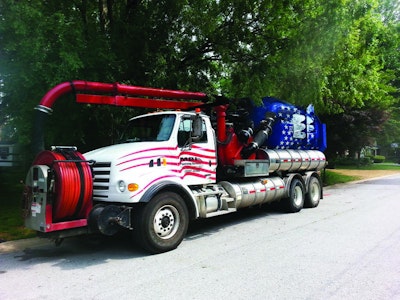
Interested in Cleaning?
Get Cleaning articles, news and videos right in your inbox! Sign up now.
Cleaning + Get AlertsInvesting in equipment for new services is a calculated risk and a decision many companies face at some point. For MBI Pipelining Services in Brookfield, Wis., that moment occurred about four years ago, when it bought a Vactor 2100 series combination vacuum truck outfitted with a hydroexcavating package.
The move paid off. In fact, MBI – a division of Musson Brothers Inc., based in Rhinelander in northern Wisconsin – now owns two Vactor 2100s. The company uses the units, made by Vactor Manufacturing, a division of Federal Signal Corp., to safely locate utilities with hydroexcavation, as well as to clean sewer lines.
MBI also performs video pipeline inspections and sewer lateral flushing and relining using a cured-in-place pipe system made by LMK Technologies, says Pat Wunsch, MBI’s district manager for pipeline services.
Both vacuum trucks are pre-owned; Jack Doheny Companies remanufactured one unit and the other was purchased from Truck Country. Both are built on Sterling LT7501 chassis and feature a 15-cubic-yard debris tank, a 1,500-gallon water tank, a Caterpillar Inc. diesel engine and a transmission made by Allison Transmission. The truck from Doheny is equipped with a positive displacement blower (4,200 cfms) made by Roots Systems Ltd. The other uses a centrifugal compressor fan (up to 5,000 cfms). The trucks’ water pumps generate maximum pressure and flow of 2,500 psi at 80 gpm, Wunsch says.
“We had been subbing out the hydroexcavating work for some time,” Wunsch notes. “While it was nice not having the expense of the vacuum trucks, we also were sending out work that we could do in-house by purchasing our own Vactor. Once our workload dictated the need to purchase, we made the investment.
“We could justify buying the unit because it’s so versatile,” he continues, noting that MBI also uses the hydroexcavating technology to quickly locate sanitary sewer laterals before installing temporary clean-outs that provide access for pipe relining work. “We also can use it for Musson Brothers [the parent company, which does infrastructure work] to expose utilities for grading and open-cut sewer work. Using high-pressure water is much faster than a guy with a shovel who’s trying to dig through compacted clay. It’s much safer too, because a guy with a shovel could scuff an electrical or gas service line.”
Using the hydroexcavators for locating utility lines on things such as road construction projects is dramatically more efficient than digging by hand. Wunsch estimates that the Vactors can pothole about 30 utilities a day at an average depth of about 3 feet, compared to five a day if doing it with a shovel.
The hydroexcavation capability also pays dividends in the lateral relining work MBI performs. It dramatically reduces the risk of damaging residential property compared to using a backhoe, for example. In fact, Wunsch says hydroexcavating can be performed less than a foot away from shrubs and other items, such as decks and sidewalks, without damaging anything.
While the units can produce water flow up to 80 gpm, Wunsch says that crews take the gpm down to 12 when excavating laterals for installation of temporary clean-outs. “That kind of work doesn’t require as much flow, plus we want to haul as little water to a dump site as possible,” he notes. “The less water that’s introduced into the debris tank, the more capacity we have to haul [hydroexcavated] dirt.”
The Vactors also reduce manpower needs on some jobs, which allows MBI to more effectively allocate employee resources to more jobs per year, which increases revenue. For example, when the company cleans manholes and catch basins, it needs one less man per job because the vac truck eliminates the need for any confined-space entry.
“That’s big for us, especially if you’re cleaning manholes all day,” Wunsch explains. “There’s a minimum of about 20 minutes of setup time for each confined-space entry. So depending on how much debris is in there and how deep the manhole is, production on manhole cleaning can go from a half a dozen a day to 20 a day. That’s a significant gain.”
To clean debris from laterals, MBI relies on four trailer-mounted water jetters (4,000 psi at up to 18 gpm) made by the Sewer Equipment Co. of America. But in the big picture, the Vactors are the company workhorses that ramp up productivity and profitability.
“They’re an essential tool in helping us achieve our ultimate production goals,” Wunsch says. “The thing that really helps us is their versatility – we can use them in almost all aspects of our business.”







